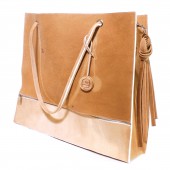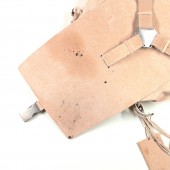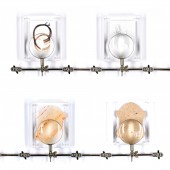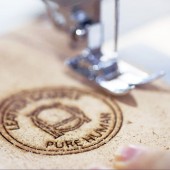Pure Human Speculative future technology tools by Tina Gorjanc |
Home > |
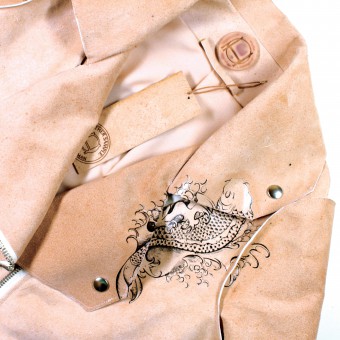 |
|
||||
| DESIGN DETAILS | |||||
| DESIGN NAME: Pure Human PRIMARY FUNCTION: Speculative future technology tools INSPIRATION: The Pure Human is a critical project that aims to speculate on a possible future application of biotechnological processes within the luxury industry. The project also aims to address shortcomings that are present in our current legal system which is enabling either an individual or organisation to claim ownership over biologically engineered products that are embedded with human genetic information. The main objective of the project I am proposing is to raise awareness of the possible issues the implementation of tissue engineering technologies might be facing while applied to new fields that are still not commonly associated with it. It aimed to achieve that by applying scenarios that have already been exposed in the medical field to the commercial market of leather goods, making it more relatable and understandable to a wider audience. The final outcome consists of a range of speculative commercial leather products cultivated from extracted human biological material. The products within the collection have been exposed to different surface manipulations. The surface alterations have been specifically selected to imitate three different modifications that human skin will undergo in the cycle of his lifetime. The purpose of this action was to expose the identity of the source and humanise beck the bodily materials usually depersonalised because of their scale. In the context of the project, a patent application has being filed on the 20/05/2016.The intention of the patent is to expose the context behind the project by showcasing that is premises is also applicable to our current commercial market and the scenario is based on actual limitations of the legal system. The right attained by claiming ownership over biological materials also redefines the genetic information as an initial source of luxury and is, therefore, advocating a possible future application of biotechnology for commercial purposes that redefines human genetic information as a new commodity. UNIQUE PROPERTIES / PROJECT DESCRIPTION: The project aims to expose loopholes that are present in the legislation dealing with biotechnologies and test how far they can be exploited in order to patent someone else's genetic information. The final outcome consists of a range of speculative commercial leather products that could be cultivated in the laboratory using extracted human genes. The products main goal is to explore the ability of such a technology to shift the perception of the production system for luxury goods as we know it and project its implementation in our current commercial market. OPERATION / FLOW / INTERACTION: - PROJECT DURATION AND LOCATION: The project started in October 2015 and finished in June 2016. It was developed as a Master Degree project at Central Saint Martins in collaboration with the Imperial College London. It was exhibited at the Milan Design Week in April 2016 as a work in progress project and in the Central Saint Martins graduate show in June 2016 in its final stage. FITS BEST INTO CATEGORY: Idea and Conceptual Design |
PRODUCTION / REALIZATION TECHNOLOGY: The future scenario has been produced using several different techniques ranging from leatherwork, metalwork, glasswork and prop design. Leatherwork includes sourcing of pig leather, thinning the leather in order to obtain the bottom offcut material - this part of the material also mimics human skin best as it is not discoloured by the chemicals - colouring the leather to obtain the uneven tones of the surface as well as small discoloration, applying silicon details that would appear on human skin in the cycle of its lifetime and production of leather products. Metalworking and glasswork - used in the creation of the chambers and the briefcase holding skin samples as well as the patent application - were employed to create display elements that would introduce the viewer in a new environment which merges the retail store with the laboratory equipment. The prop design present in the work varies from temperature and pH monitors to silicon skin drafts and petri dish content to convey a well researched and overall design of the scenario. More in-depth research was also carried out in terms of the actual viability of the proposed procedures. The research methodologies include extensive interviews with experts as well as a small portion of laboratory work. The proposed procedure to produce the leather goods could be carried out using and combining processes that are already present in different laboratories around the globe. It would begin by extracting biological information from the source using a gene editing technique CRISPRCas9. The process of growing human tissue would involve spreading collagen gel with embedded fibroblasts on the bottom of a petri dish. The gel is used as a platform for the growth of keratinocytes from a culture insert that is immersed in a solution full of growth nutrients. The next step includes an introduction of an air-liquid interface that lifts the culture insert. This induces keratinocytes to stratify and to differentiate to form different multiple layers. When the skin draft reaches a specific size and thickness the growth can be stopped which causes cell death that allows the material to be exposed to a non-controlled environment. Conventional tanning techniques can be applied at this point which converts the skin into leather as well as preserves the material. SPECIFICATIONS / TECHNICAL PROPERTIES: The display of the future scenario includes: -three temperature chambers each including a leather object (beach bag, backpack and leather jacket): Chamber 1 H: 960mm W: 580mm L: 630mm, Chamber 2 H: 760mm W: 380mm L: 430mm, Chamber 3 H: 560mm W: 730mm L: 430mm, - metallic briefcase including the patent application for the material, DNA code certificate, extracted genetic information in a test tube and skin sample in a petri dish. The dimension of open briefcase: H: 45mm W: 540mm L: 420mm, - transparent plinth with 5 samples in the glass showing the process for growing the material. Plinth dimensions: H: 80mm W: 550mm L: 250mm, - one glass frame containing the care label for the material. Dimensions: H: 8mm W: 160mm L: 220mm. TAGS: Biodesign, Human, Bio-engineering, Critical, Speculative, Future, Luxury, Leather, Laboratory, Invitro RESEARCH ABSTRACT: - CHALLENGE: - ADDED DATE: 2016-06-29 21:16:41 TEAM MEMBERS (1) : IMAGE CREDITS: Image #1: Designer Tina Gorjanc, Tattooed jacket, 2016 Image #2: Designer Tina Gorjanc, Sun-tanned beach-bag, 2016 Image #3: Designer Tina Gorjanc, Freckled backpack, 2016 Image #4: Designer Tina Gorjanc, Process to obtain laboratory leather, 2016 Image #5: Documentary designer Sidonie Garnier and Documentary producer Maryam Goormaghtigh - Arte, Detail of the material, 2016 PATENTS/COPYRIGHTS: Patented. GB1608948.4. Tina Gorjanc. 2016. UK Patent Office. |
||||
| Visit the following page to learn more: http://tinyurl.com/jfkd3rz | |||||
| SOCIAL |
| + Add to Likes / Favorites | Send to My Email | Comment | Testimonials | View Press-Release | Press Kit |

